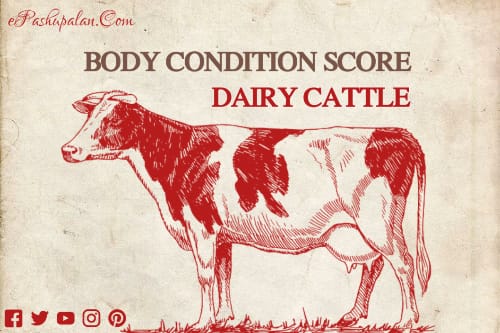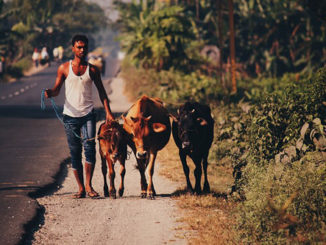Some traits of animals are those which support high production or increase ability of animals for longer productivity life. Traditionally, the farmers in India had been placing emphasis on selection of good functional characters during selection of good quality animal but with passage of time functional characters were diluted and more emphasis was given to appearance, colour and horn shape. With type classification of animals body characters of animals that are functionally important are reintroduced. The physical appearance of animals in terms of all body characters associated with productivity and fertility of animal is termed as type. The traits collectively define the type of animals are called type traits. The classification of animals on basis of their type traits is termed as type classification or scoring.

During selection of animal for milk production, it should be ensured that body of animal should be able to sustain high level of production. Selection solely based on milk yield may provide short term gains but is prone to problems which include reduced feed conversion efficacy, mastitis, locomotion problems, dystocia and infertility. All these problems affect life time production performance of the animal.
Type classification for functional traits is required for breed improvement programme to facilitate selection of dams and sires to produce next generation of animals.
Type classification is done on linear scales in the form of scores for standard type traits. These traits have high to moderate hereditability and many of these traits which are taken under consideration are also correlated on varying degree with production traits .They are often correlated with each other . So selection of animals on a particular type trait also impacts production as well as concerned correlated traits. These attributes of type traits make it possible to select and improve type traits at a much rapid pace than production and fertility traits. Type classification also help in decision making related to purchase, breeding and sale of animals.
In type classification, measurement of type traits is linear scoring which has some advantages:–
- Variations within traits is identifiable.
- Traits are scored individually.
- Scoring is based on measurements.
Type traits help in evaluation and selection of animals. Due to high heritability of type traits, there is faster improvement of these traits in next generation. The standard traits to be considered during type classification are mentioned below. They are divided into five major categories.
- Dairy Strength
- Stature
- Heart girth
- Body Length
- Body Depth
- Angularity
- Rump
- Rump Angle
- Rump width
- Feet And Legs
- Rear Leg Set
- Rear leg Rear View
- Foot Angle
- Udder:-
- Fore Udder Attachment
- Rear Udder Attachment
- Central Ligament
- Udder Depth
- Front Leg Placement
- Teat Length
- Rear Teat Placement
- Rear Udder Width
- Teat thickness
General Body Condition Score
The type classification of dairy animals should be done in first lactation between 2 to 4 months postpartum. If animals in first lactation are not available, animals in any lactation may be scored between 2 to 5 months of lactation. On the day of type classification, this exercise should be done during day time between at least three hours after morning milking and one hour before evening milking. During type classification animal should be standing on levelled surface. Score which are given to each trait are on 1-9 range
Instruments to be used for type classification for different traits
- For stature, rump angle, udder width retractable measuring tape with levelling bubble and telescoping rod like attachment is used.
- Body depth, body length and heart girth is measured by measuring tape.
- Rump width, rump udder height, teat length, rear udder is measured by ruler.
- Teat thickness by Vernier caliper with digital scale.
- Angularity by device using two wooden pieces and protector.
Methodology for type classification
Stature: It is measured from top spine in between hips to ground. Scores given to different type of stature are
- Short stature—-1
- Intermediate stature:- 5
- Tall stature—9
Heart Girth: It is circumference of thorax at the point of elbow. Scores given to different type of heart girth are
- Narrow Heart girth—-1
- Intermediate Heart girth—–5
- Wide Heart girth—–9
Body Length: It is measured between point of shoulder and pin bone and points given to body length are
- Short Body Length——–1
- Intermediate Body Length—5
- Long Body Length—9
Body Depth: is distance between top of spine and bottom of barrel at last rib. This would be half of body girth at the deepest point of barrel. Points to be given to body depth are
- Shallow Body Depth—-1
- Intermediate Body Depth—5
- Deep Body Depth—9
Angularity: t is the angle formed between the two imaginary lines—one perpendicular to the floor and other through last rib. Points to be given to it are
- Non Angular—1
- Intermediate angularity—5
- Deep Angularity—-9
Rump Angle: It is the angle of the rump from hip to pin. Two straight imaginary lines,one from point of hip and uppermost point of pin. The distance between them can be considered. If pin bone is below hip bone, measure is considered positive, otherwise it is negative. Points given to it are
- If distance is negative(High)—–1
- If distance intermediate——5
- If distance is positive(Low)—9
Ramp Width: It is the distance between most posterior point of pin bone. Scores given to it are
- If distance is narrow—-1
- If distance is intermediate—-5
- If distance is wide—-9
Rear Legs Rear View: It is the direction of rear feet when viewed from rear and points given to it are
- If distance narrow(hooked in) it is scored—1
- If intermediate it is scored—5
- If straight it is scored—9
Rear Legs Set: Angle measured at the front of hock. It is evaluated by assuming an imaginary line from foot through hock.points given to this trait are
- If is is straight it is scored—-1
- If it is intermediate it is scored—5
- If it is curved it is scored—-9
Foot Angle: Angle at the front of rear hoof measured from the floor to the hair line at the right hoof. It can be evaluated by imaginary line through the hairline of hoof. It is scored as
- If it is low it is scored —–1
- If it is intermediate it is scored—5
- If it is steep it is scored—9
Fore Udder Attachment: It is the strength of attachment of the fore udder to the abdominal wall. It is scored as
- If udder attachment is weak it is scored—1
- If udder attachment is intermediate it is scored—5
- If udder attachment is strong it is scored—9
Front Teat Placement: The ;position of the front teat from centre of quarter as viewed from rear. It is scored as
- If front teat placement is wide it is scored—1
- If front teat placement is intermediate it is scored—5
- If front teat placement is close it is scored—9
Teat Length: The length of the left front teat for cattle and left rear teat for buffalo. This trait is scored as
- If teat length is short it is scored—1
- If teat length is intermediate it is scored—5
- If teat length is long it is scored—9
Udder Depth: The distance from the lowest part of udder floor to an imaginary line through hock. It is scored as
- If it is deep(distance less) it is scored —-1
- If it is intermediate it is scored—–5
- If it is shallow it is scored—–9
Rear udder Height: The distance between the bottom of the vulva and rear point of attachment of mammary gland. It is scored as
- If it is low(more distance) it is scored—1
- If it is intermediate it is scored—-5
- If it is high(less distance) it is scored—9
Central Ligament: The depth of cleft, measured at the base of the rear udder. This trait is scored as
- If it is weak(less) it is scored—1
- If it is intermediate it is scored—5
- If it is strong it is scored—9
Rear Teat Placement: The position of rear teat from centre of quarter. It is scored as
- If it is wide it is scored—1
- If it is intermediate it is scored—5
- If it is close it is scored—9
Rear Udder Width: It is the width at the position where mammary gland is attached to the body at the rear. It is scored as
- If it is narrow it is scored—1
- If it is intermediate it is scored—5
- If it is wide it is scored—9
Teat Thickness: The thickness is measured by Vernier caliper at the middle of the left front teat of cattle and left rear teat in buffalo.
Body Condition Score: Body condition scoring is concerned with two specific areas for assessment of fat covers. One is the loin area which consists spinous and transverse processes of lumber vertebrae and the other area is tail head and pin bones.
Score Description
- Very Thin(Emaciated): Animal markedly emaciated, bone structure easily seen, little muscle present, animal weak, lethargic.
- Thin: Animal emaciated, bone structure prominent, some muscle development, thin neck, area around tail head completely sunken.
- Less Thin: Vertebral column prominent, little fat, super spinous muscle over spinous processes, little muscle or fat covering over withers and shoulders.
- Moderate: Super spinous muscles developed and readily apparent. vertebral column can be felt. Some fat can be felt in shoulder area region and at base of neck, can feel ribs but not visible.
- Less Fat: Back flat, cannot feel spinous processes, fat on neck and shoulder area beginning to expand over ribs, flanks filling, neck thickening.
- Fat: Animal appears well covered with body rounded with fat and bones not visible, flanks filled, broad back.
- Very Fat(Obese): Bones buried in fat, back broad or flat, in some cases crease along the backbone, large accumulations of fat on neck, over shoulder area and ribs, flank filled with fat.







nyc info
Nice info